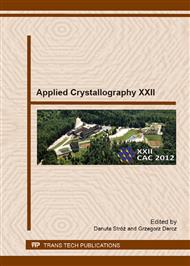p.380
p.386
p.390
p.394
p.398
p.402
p.406
p.411
p.417
Changes in the Structure of Palladium Nanograins in the Carbon Film (C-nPd) under the Influence of Hydrogen
Abstract:
Carbonaceous – nanopalladium (C-nPd) films on insulating substrates, obtained by PVD (Physical Vapor Deposition) followed by the annealing method, are used for hydrogen sensors. In this paper we present the results of XRD, SEM and electrical measurements of C-nPd films grown by PVD and then either annealed in an inert atmosphere or modified by CVD (Chemical Vapor Deposition). The structure of palladium grains were measured in a H2/N2 gas mixture atmosphere containing H2 in the concentration range 0-4%. Our measurements showed that C-nPd films prepared by PVD and annealing method were flat and they consisted of sphere-like palladium nano-particles, uniformly distributed in the low-ordered carbon matrix. Effect of hydrogen partial pressure on the crystal structure was studied in situ in GIXD measurements, using a specially designed measuring holder cell. It was observed that at low partial pressure of hydrogen, palladium fcc metal particles transformed into solid solution Pd(H) (α-phase), which occurs in the fcc structure as well. Lattice constant of that solid solution increases with increasing hydrogen partial pressure in the gas atmosphere. After exceeding the critical value of the partial pressure of hydrogen, palladium transforms into the structure of palladium hydride PdHx (β-phase), which has significantly larger lattice constant. This critical value of hydrogen partial pressure depends on the initial structure of C-nPd film, and consequently on the parameters of PVD process and annealing. This value usually corresponds to a few percent hydrogen content in gas mixture.
Info:
Periodical:
Pages:
398-401
Citation:
Online since:
June 2013
Price:
Сopyright:
© 2013 Trans Tech Publications Ltd. All Rights Reserved
Share:
Citation:


